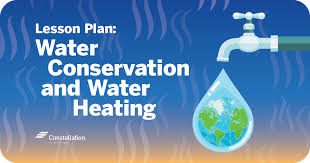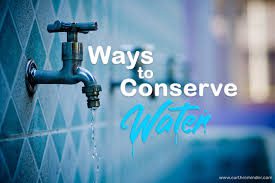Environmental management tips for conserving water involves taking actions to protect and wisely use water resources. It means making choices and implementing practices that reduce water waste and ensure sustainable water use.
One key aspect is promptly fixing any leaks in your home or workplace. Leaks can waste a surprising amount of water over time, and addressing them is a fundamental step in efficient water management.
These tips aim to ensure the availability of clean water for both current and future generations, contributing to the sustainable use of this vital resource and minimizing the environmental impact associated with excessive water consumption.
Tips for Conserving Water
Below are tips for conserving water;
1. Fix Leaks Promptly: Identifying and repairing leaks in faucets, pipes, and irrigation systems is a simple yet effective way to prevent water wastage. A dripping faucet may seem minor, but it can lead to significant water loss over time.
2. Install Water-Saving Devices: Upgrade your home with water-efficient appliances and fixtures. High-efficiency toilets, low-flow showerheads, and smart irrigation systems are examples of technology that can help reduce water consumption without sacrificing convenience.
3. Collect Rainwater: Set up rain barrels or other collection systems to harvest rainwater. This collected water can be used for watering plants, washing cars, or other non-potable water needs, reducing reliance on treated water for such activities.
4. Practice Smart Watering: Adjust your watering schedule based on weather conditions. Watering early in the morning or late in the evening reduces evaporation, ensuring that more water reaches the plants’ roots. Use drip irrigation or soaker hoses for targeted watering.
5. Landscape Wisely: Choose native and drought-resistant plants for your garden. These plants are adapted to local conditions and generally require less water. Mulching around plants helps retain soil moisture and reduces the need for frequent watering.
6. Limit Shower Time: Shortening your shower time and turning off the water while soaping or shampooing can significantly cut down water usage. Encourage family members to be mindful of their shower habits to collectively conserve water.
7. Full Loads Only: When using washing machines and dishwashers, make sure to run full loads. This maximizes the efficiency of each cycle, reducing the number of overall washes and, consequently, water consumption.
8. Educate Others: Raise awareness about water conservation within your community. Share tips and information on social media, participate in local environmental initiatives, and encourage others to adopt water-saving practices.
By incorporating these simple yet impactful practices into daily life, individuals contribute to environmental management by conserving water resources. These efforts, when multiplied across communities, make a significant positive impact on the overall health of our environment.
Read Also: Effective Marketing Strategies for Waste Management Businesses
Water-Efficient Appliances

Upgrading your appliances can be a smart move for both your wallet and the environment. Consider investing in water-efficient appliances, like low-flow toilets and water-saving washing machines. Here’s why:
1. Low-Flow Toilets: Traditional toilets can use a lot of water with each flush. Low-flow toilets are designed to use less water while still effectively clearing the bowl. By making this switch, you save water every time you flush.
2. Water-Saving Washing Machines: Old washing machines might use more water than necessary. Water-saving washing machines are designed to use less water per load without compromising on cleaning power. This means you get your clothes clean while using fewer resources.
3. Reduced Water Bills: Water-efficient appliances not only help conserve a precious resource but also contribute to lower water bills. Over time, the savings can add up, making these appliances a cost-effective choice.
4. Environmental Impact: Conserving water is crucial for the environment. By using water-efficient appliances, you reduce your overall water consumption, easing the strain on local water supplies and promoting a more sustainable lifestyle.
5. Government Rebates and Incentives: In some places, there are government programs that offer rebates or incentives for upgrading to water-efficient appliances. This can make the initial investment more affordable and provide additional motivation to make the switch.
6. Easy to Install and Use: Installing water-efficient appliances is usually a straightforward process. They are designed to be user-friendly, so you won’t need a complicated manual to understand how to use them effectively.
7. Long-Term Investment: Think of these appliances as a long-term investment. Not only do they contribute to water conservation immediately, but they also add value to your home and may attract environmentally conscious buyers if you decide to sell in the future.
By exploring and investing in water-efficient appliances, you contribute to a more sustainable and water-conscious lifestyle, making a positive impact on both your household and the planet.
The Importance of Environmental Management Tips for Conserving Water
Environmental management involves responsible and sustainable practices to protect and utilize natural resources wisely. Within this framework, conserving water emerges as a critical component. It refers to the deliberate efforts made by individuals, communities, and organizations to use water efficiently and preserve this precious resource for future generations. Here are the importance of preserving water;
1. Preserving Ecosystems: Conserving water is vital for maintaining healthy ecosystems. Many plants and animals rely on specific water conditions to thrive. By using water responsibly, we help sustain the natural balance of aquatic environments, supporting biodiversity.
2. Ensuring Water Availability: Water scarcity is a growing global concern. By managing water resources carefully, we contribute to ensuring a stable and adequate water supply for current and future needs. This is crucial for agriculture, industry, and, most importantly, for human consumption.
3. Mitigating Drought Impact: Conserving water helps communities better withstand periods of drought. When water is used efficiently, there’s a reduced risk of water shortages during dry spells, preventing negative impacts on agriculture, drinking water supplies, and overall community well-being.
4. Reducing Energy Consumption: The energy used to extract, treat, and distribute water is substantial. By using less water, we indirectly reduce the energy demand associated with these processes. This, in turn, contributes to lowering greenhouse gas emissions and mitigating climate change effects.
5. Protecting Water Quality: Overuse and contamination of water sources jeopardize water quality. Environmental management practices, such as minimizing chemical runoff and wastewater discharges, help maintain the purity of water bodies, ensuring they remain safe for consumption and recreation.
6. Mitigating Flood Risks: Poor land management and excessive water use can contribute to increased flood risks. Conserving water through sustainable practices, such as planting trees and adopting permeable surfaces, helps regulate water flow and reduces the likelihood of flooding.
7. Promoting Sustainable Agriculture: Agriculture is a major consumer of water. Implementing water-conserving practices in farming, such as precision irrigation and soil moisture monitoring, not only saves water but also promotes sustainable agricultural practices that benefit both farmers and the environment.
8. Fostering a Conservation Mindset: Environmental management tips for water conservation play a crucial role in fostering a broader conservation mindset. When individuals and communities actively engage in water-saving practices, it creates a culture of environmental responsibility that extends to other aspects of resource management.
The importance of environmental management tips for conserving water goes beyond individual actions; it contributes to global efforts to address water scarcity, protect ecosystems, and build resilient communities. Embracing these practices is a collective responsibility that ensures a sustainable and healthier future for our planet.
Ways to Reduce Water Waste and Ensure Sustainable Water Use

Reducing water waste and ensuring sustainable water use is essential for the well-being of our planet. Here are practical ways to achieve this;
1. Fix Leaks Promptly: Identify and repair leaks in faucets, pipes, and toilets. Even small leaks can add up to significant water waste over time.
2. Collect Rainwater: Utilize rain barrels to collect rainwater. This harvested water can be used for watering plants, reducing the reliance on treated water for non-potable needs.
3. Mindful Watering: Water your plants during the early morning or late evening to minimize evaporation. Adjust irrigation systems to avoid watering when it’s unnecessary.
4. Mulching: Apply mulch around plants to retain soil moisture. This simple practice reduces the need for frequent watering and promotes healthier plants.
5. Choose Water-Efficient Appliances: Upgrade to water-saving appliances such as low-flow toilets and washing machines. These devices are designed to maintain functionality while using less water.
6. Smart Landscaping: Opt for drought-resistant plants and use native species in landscaping. These plants are adapted to local conditions and generally require less water.
7. Efficient Lawn Care: Set your lawnmower to a higher cutting height. Taller grass provides shade to the soil, reducing water evaporation and promoting stronger root systems.
8. Educate and Raise Awareness: Inform and involve others in your community about the importance of water conservation. Simple practices, when adopted widely, can have a significant collective impact.
9. Responsible Household Practices: Encourage water-saving habits within your household, such as turning off taps tightly, fixing leaks promptly, and using appliances efficiently.
10. Monitor Water Usage: Keep track of your water consumption. This awareness can lead to more conscious efforts to reduce usage and prevent unnecessary waste.
By incorporating these straightforward practices into daily life, individuals can contribute to sustainable water use, safeguarding this precious resource for future generations.
Read Also: The Best Environmental Management Tips for Reducing Pollution
Advantages and Disadvantages of Environmental Management Tips for Conserving Water

Advantages
Below are the advantages of environmental management tips for conserving water;
1. Sustainable Resource Use: Environmental management tips for conserving water promote sustainable use of this precious resource. By adopting responsible practices, we ensure that water remains available for future generations, supporting long-term environmental health.
2. Biodiversity Preservation: Efficient water use contributes to preserving ecosystems and biodiversity. Conserving water helps maintain natural habitats, ensuring that plants and animals dependent on specific water conditions can thrive.
3. Economic Savings: Water conservation often leads to cost savings. Individuals and businesses that implement water-saving practices can reduce their water bills, while governments can save on infrastructure costs associated with water treatment and distribution.
4. Climate Change Mitigation: Using less water indirectly reduces energy consumption in water-related processes. This contributes to lower greenhouse gas emissions, aligning with global efforts to mitigate climate change and promote environmental sustainability.
5. Resilience to Drought: Communities practicing water conservation are better prepared to face drought conditions. By reducing water demand and optimizing usage, these communities mitigate the impact of water scarcity on agriculture, industry, and daily life.
6. Improved Water Quality: Environmental management tips help protect water quality by minimizing pollution and contaminants. This ensures that water sources remain safe for consumption, recreation, and supporting various ecosystems.
Disadvantages
Below are the disadvantages of environmental management tips for conserving water;
1. Initial Costs of Implementation: Some water-saving technologies and practices may involve upfront costs for installation and upgrades. This initial investment can be a barrier for individuals or businesses with limited financial resources.
2. Behavioral Change Challenges: Implementing water-conserving practices often requires a change in behavior. Overcoming habits and convincing individuals to adopt new approaches can be challenging and may take time.
3. Impact on Agriculture: While water conservation is crucial, strict water-use restrictions can pose challenges for agriculture. Farmers may face difficulties in maintaining crop yields if not provided with sustainable alternatives and support.
4. Limited Impact on Global Water Issues: While local conservation efforts are essential, they may have limited impact on broader global water challenges, such as transboundary water disputes and disparities in water access between regions.
5. Potential for Unintended Consequences: Some water-saving interventions may have unintended consequences. For example, altering natural water flow patterns can impact aquatic ecosystems, and certain water-saving technologies may have environmental drawbacks.
6. Resistance to Regulation: Implementing water conservation may face resistance, especially in cases where regulations are perceived as restrictive. Balancing the need for conservation with public acceptance and cooperation can be a delicate task.
While environmental management tips for conserving water offer numerous advantages, it’s important to consider potential disadvantages and address them through thoughtful planning, community engagement, and ongoing evaluation of conservation strategies.
Read Also: 27 Most Successful Small Town Business Ideas

